La Earhcache / The Earhcache
► Les grottes de Rajat : lieux et contexte géologique
A la limite entre Murol et Beaune Le Froid se trouve les grottes troglodytiques de Rajat. Elles ont été habitées à une époque lointaine, quelques ouvertures taillées dans la roche en témoignent.
L'étude géologique du site de Rajat nous montre que nous sommes sur un escarpement issu d'un Volcanisme pliocène du plateau des Dômes, il y a deux millions d'années. Il s'agit d'un centre d'émission volcanique, un reste de cône.
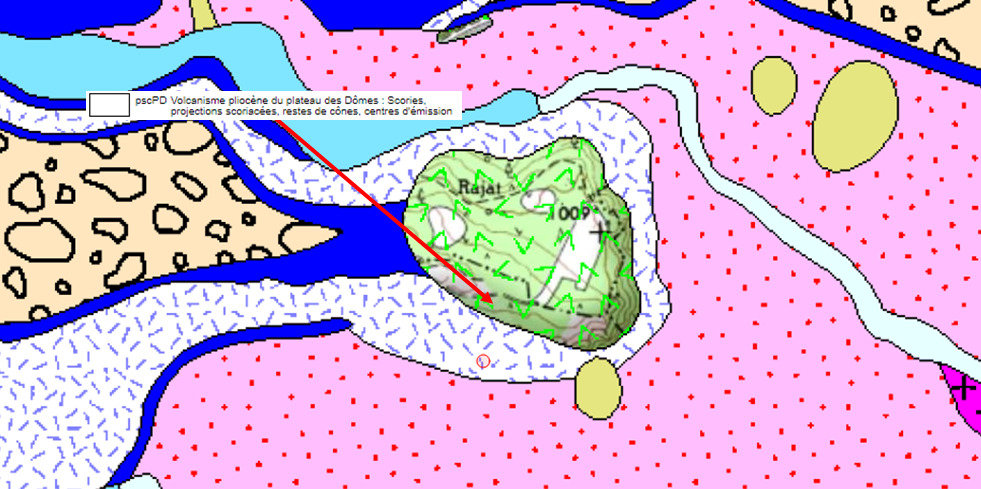
Les images qu'on se fait des scories des volcans auvergnats est généralement un grand amas de pyroclastes meuble et non cohérent, bien loin d'un substrat présentant suffisamment de cohérence pour en faire des grottes habitables.
Quel est ce substrat particulier et dans quelles conditions s'est-il mise en place ?
► Le Tuf, conglomérat bréchique et volcanique
Un conglomérat est une roche composée de morceaux discernables (mesurant plus de 2 mm) liés entre eux par un ciment naturel.
Dans ces conglomérats, les brèches sont majoritairement composés de clastes anguleux.
La lithologie des éléments permet de distinguer une brèche monogénique composée d'éléments de même nature et une brèche polygénique composée d'éléments de natures différentes.
Il existe plusieurs types de brèches :
- Une brèche sédimentaire est une roche détritique formée par l'accumulation d'éléments anguleux ayant subi un faible transport.
- Une brèche tectonique est issue de la fragmentation de roches dans un contexte tectonique. Il existe plusieurs sortes de brèches tectoniques, suivant la nature de la matrice et du ciment.
- Une brèche volcanique est composée de fragments de roches magmatiques volcaniques et d'un ciment de cendres et de lapillis.
Dans les brèches volcaniques, on en distingue deux types selon la nature des clastes et conditions de formation :
- Les Tufs rhyolitiques : de couleur claire (gris-blanc) et tendres (ils se raient sans souci avec une clef en métal), ces tuf sont des roches acides issues d'éruptions péléennes. La consolidation en conglomérat s'est fait sous l'action de l'eau (ex : fumerolles persistantes).
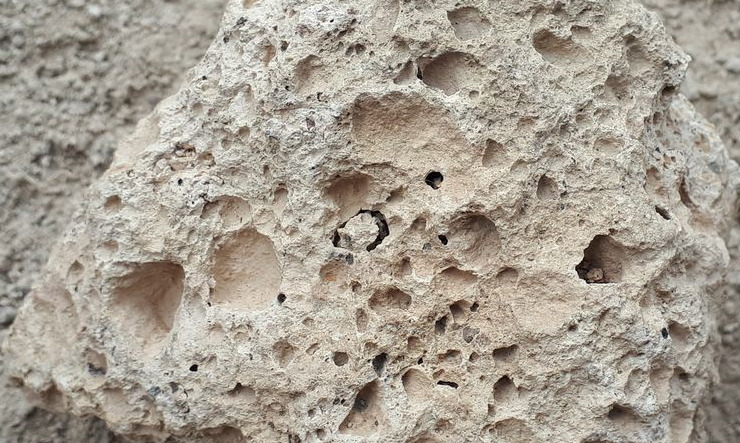
- Les Tufs basaltiques : de couleur rouge ou bleue, ces tufs sont des agglomérats de clastes basaltiques, une roche basique et dure (elle ne se raie pas avec un clef en métal).
Émis par des volcans stromboliens, ces clastes basaltiques se cimentent en conglomérats volcaniques sous l'effet des fortes températures (cœur du cône volcanique et/ou présence de dykes de lave en fusion) et des conditions de contraintes pendant la soudure.
La coloration de ces tufs va dépendre de la température des scories lors de éruptions : bleues à l'origine, les pyroclastes au cœur du cône vont devenir rougeâtre du fait de l'oxydation du fer contenu dans les minéraux sous l'action des fortes températures (supérieures à 600 degrés).
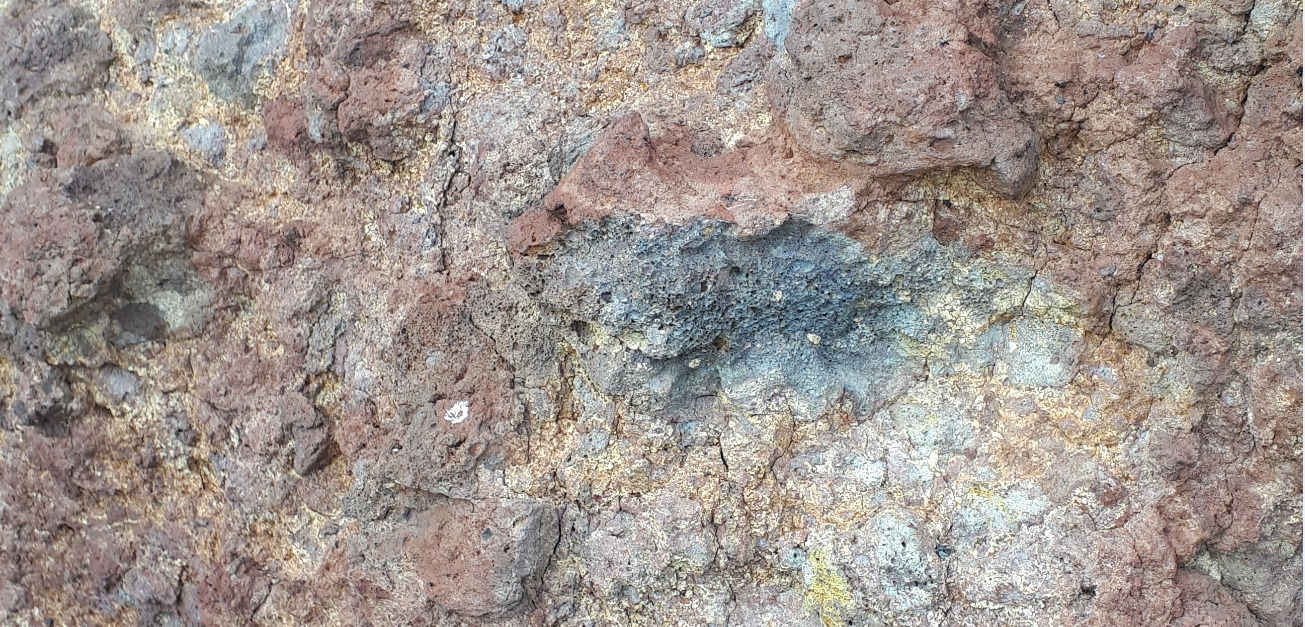
► Le Dyke, filon magmatique
Un dyke est un filon de roche qui s'est injecté dans une fracturation de l'encaissant. De ce fait, un dyke recoupe les autres roches qu'il traverse.
La plupart des dykes sont constitués de roches magmatiques qui se sont injectées à l'état liquide.
Dans le cadre des formations des cheminées volcaniques, les cônes sont formés de pyroclastes non cohérents, propice à la mise en place de déplacements de terrain et de fracturation dans lesquels va s'infiltrer un magma liquide très fluide remontant de la cheminée.
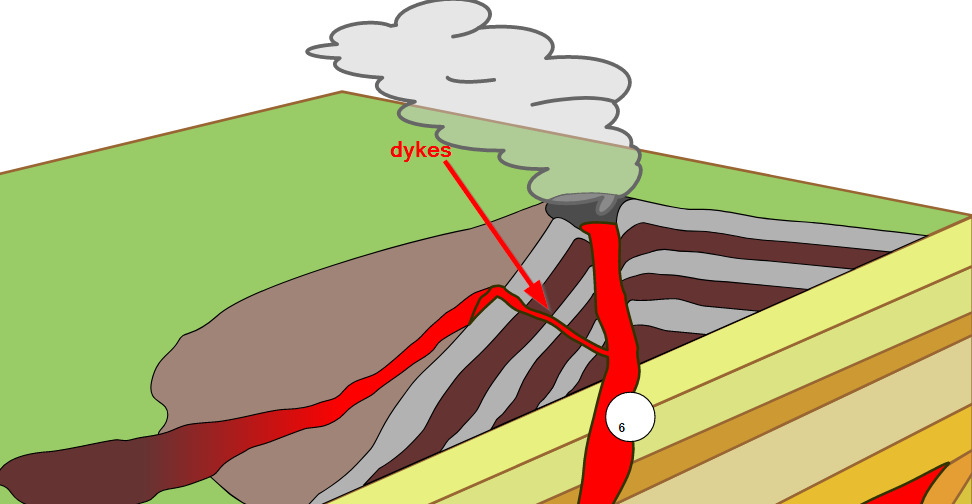
Ces veines de lave vont se refroidir progressivement, formant des filons basaltiques.
Le basalte formé est une roche de couleur bleuté-grise sombre avec une structure microlithique (cristaux invisibles à l'oeil nu). C'est une roche dure et cohérente.
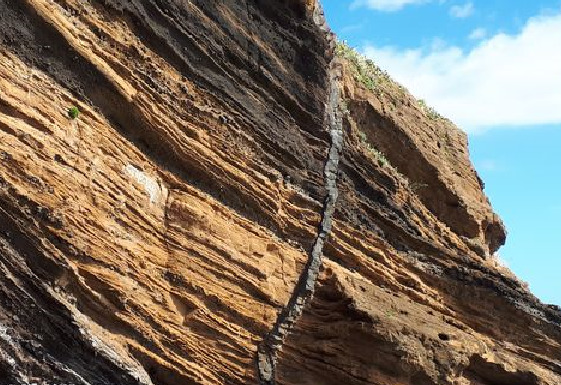
► Principe de datation géologique
Il existe plusieurs type de datation relative des roches et événements géologiques.
L'un d'entre eux est le principe de recoupement : Un événement (intrusion magmatique, faille, plissement, discordance, érosion) qui provoque un changement dans la géométrie des roches est postérieur à la dernière strate qu'il affecte et antérieur à la première strate non affectée.
Autrement dit, tout événement géologique qui en recoupe un autre lui est postérieur.
Dans l’exemple ci-dessous, le filon F est postérieur aux strates 1 et 2, mais antérieure à la strate 3.
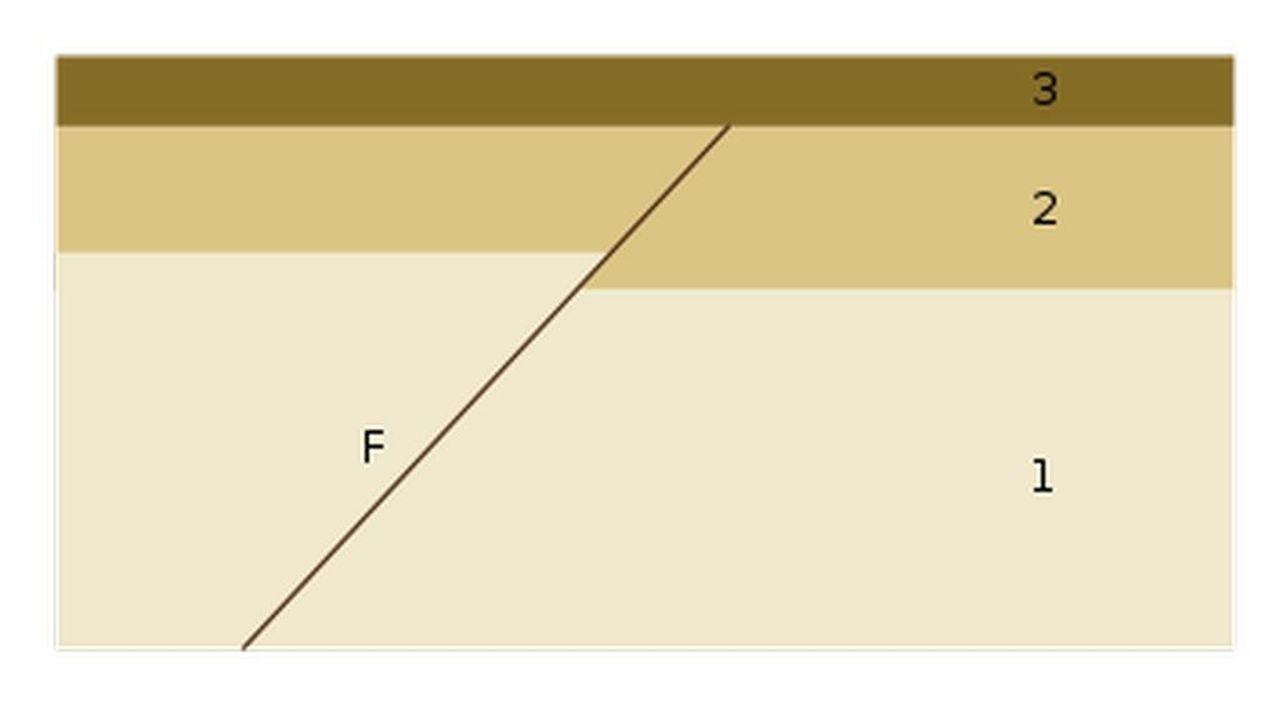
► The caves of Rajat: places and geological context
At the border between Murol and Beaune Le Froid is the troglodyte caves of Rajat. They were inhabited in a distant time, some openings cut in the rock testify to it.
The geological study of the Rajat site shows us that we are on an escarpment resulting from a Pliocene volcanism of the Domes plateau, two million years ago. It is a volcanic emission center, a remnant of a cone.
The images we make of the slag from Auvergne volcanoes is generally a large pile of loose and non-coherent pyroclasts, far from a substrate with enough coherence to make them habitable caves.
What is this particular substrate and under what conditions did it take place?
► Tuff, brecciated and volcanic conglomerate
A conglomerate is a rock composed of discernible pieces (measuring more than 2 mm) linked together by a natural cement.
In these conglomerates, the breccias are mainly composed of angular clasts.
The lithology of the elements makes it possible to distinguish a monogenic breccia made up of elements of the same nature and a polygenic breccia made up of elements of different natures.
There are several types of breaches: - A sedimentary breccia is a detrital rock formed by the accumulation of angular elements having undergone a weak transport.
- A tectonic breach results from the fragmentation of rocks in a tectonic context. There are several kinds of tectonic breccias, depending on the nature of the matrix and the cement.
- A volcanic breccia is composed of fragments of volcanic magmatic rocks and a cement of ash and lapilli.
In volcanic breccias, there are two types depending on the nature of the clasts and the formation conditions:
- Rhyolitic Tuffs: light in color (gray-white) and tender (they are laughed without concern with a metal key), these tuff are acid rocks resulting from Pelean eruptions. Consolidation into a conglomerate was done under the action of water (eg persistent fumaroles).
- Basaltic Tuffs: red or blue in color, these tuffs are agglomerates of basaltic clasts, a basic and hard rock (it is not scratched with a metal key).
Emitted by Strombolian volcanoes, these basalt clasts are cemented into volcanic conglomerates under the effect of high temperatures (heart of the volcanic cone and / or presence of molten lava dykes) and stress conditions during the weld.
The coloring of these tuffs will depend on the temperature of the slag during eruptions: originally blue, the pyroclasts at the heart of the cone will become reddish due to the oxidation of the iron contained in the minerals under the action of high temperatures (greater than 600 degrees).
► The Dyke, magmatic vein
A dyke is a vein of rock which has been injected into a fracturing of the surrounding. As a result, a dyke cuts across the other rocks it crosses.
Most dykes are made up of magmatic rocks which are injected in the liquid state.
Within the framework of the volcanic chimney formations, the cones are formed of non-coherent pyroclasts, favorable to the establishment of ground displacements and fracturing in which will infiltrate a very fluid liquid magma rising from the chimney.
These lava veins will gradually cool, forming basaltic veins.
The basalt formed is a dark bluish-gray colored rock with a microlithic structure (crystals invisible to the naked eye). It is a hard and consistent rock.
► Principle of geological dating
There are several types of relative dating of rocks and geological events.
One of them is the principle of overlap: An event (magmatic intrusion, fault, folding, discordance, erosion) which causes a change in the geometry of the rocks is after the last stratum which it affects and before the first stratum not affected.
In other words, any geological event which overlaps another one is subsequent to it.
In the example below, vein F is posterior to strata 1 and 2, but anterior to stratum 3.
► Sources bibliographiques / Bibliographical sources
Les Questions / The Questions
Questions pour valider :"Tufs et Dykes à Rajat"
Questions to validate: "Tuffs and Dykes in Rajat"
- Question 0 : Prenez une photo de vous ou d'un élément vous identifiant avec les grottes de Rajat en arrière plan.
Cette photo devra au choix nous être transmise avec les réponses ou être ajoutée à votre log.
-Question 0 : Take a picture of yourself or something identifying you with the Rajat caves in the background.
This photo must either be sent to us with the answers or added to your log.
Vous voici à la base des grottes troglodytiques de Rajat.
Here you are at the base of the troglodyte caves of Rajat.
- Question 1 : Décrivez le conglomérat devant vous (composition monogénique ou polygénique, couleur principale, taille et formes des clastes, couleur du ciment). Essayez de rayer les clastes avec une clef en métal. Déduisez-en le type de brèche et la nature du tuf.
- Question 1: Describe the conglomerate in front of you (monogenic or polygenic composition, main color, size and shape of the clasts, color of the cement). Try to scratch the clasts with a metal key. Deduce the type of breach and the nature of the tuff.
- Question 2 : La couleur du site vous paraît-elle cohérente par rapport à la carte géologique ?
- Question 2 : Do you think the color of the site is consistent with the geological map?
Observons la partie gauche de la falaise principale, au niveau de hauteur de la fenêtre ouverte taillée dans la roche (photo WP1).
Let us observe the left side of the main cliff, at the height of the open window cut in the rock (photo WP1).
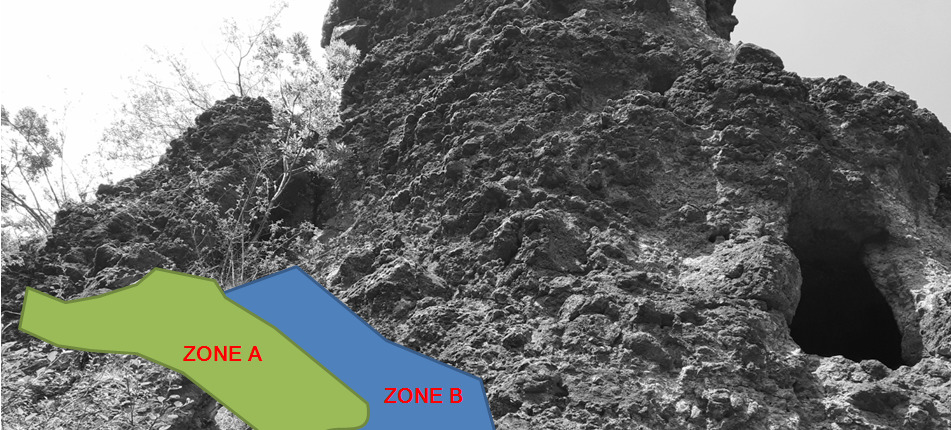
- Question 3 : Décrivez ce que vous voyez sous la zone A verte. De quoi s'agit-il ? Quelle est sa nature et comment cela s'est-il formé ?
- Question 2 : Describe what you see under the green area A. What is it about ? What is its nature and how did it form?
- Question 4 : D'un point de stratigraphique, estimez l'âge relatif de la zone B bleue par rapport à la zone A verte.
- Question 4 : From a stratigraphic point, estimate the relative age of the blue zone B compared to the green zone A.
Vous pouvez vous loguer sans attendre notre confirmation,
mais vous devez nous envoyer les réponses par mail en même temps via notre profil (
fafahakkai).
S'il y a des problèmes avec vos réponses nous vous en ferons part.
Les logs enregistrés sans réponses seront supprimés.Une photo de vous ou de votre GPS à un des WPs (mais sans prendre en photo le panneau ou les spots d'observation) serait la bienvenue, mais n'est pas obligatoire
You can log this cache without waiting for our confirmation, but you must send us the answers by e-mail at the same time via our profile (fafahakkai).
If there is a problem with your answers we will notify you. The logs recorded without answers will be deleted.
A picture of you or your GPS to a WPs (but not to photograph the sign or observation spots) would be welcome but is not mandatory.
Rappel concernant les « Earthcaches »: Il n'y a pas de conteneur à rechercher ni de logbook à renseigner. Il suffit de se rendre sur les lieux, de répondre aux questions ci-dessus et de nous renvoyer les réponses.
Reminder concerning "Earthcaches": there is neither a container to look for nor a logbook to sign. One need only go to the location, answer to the differents quiestions and send us the answers.